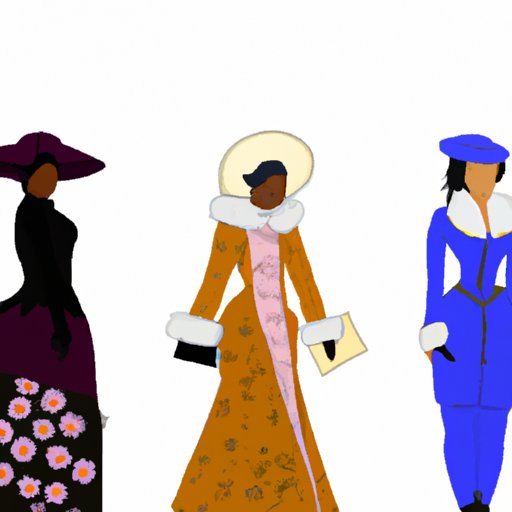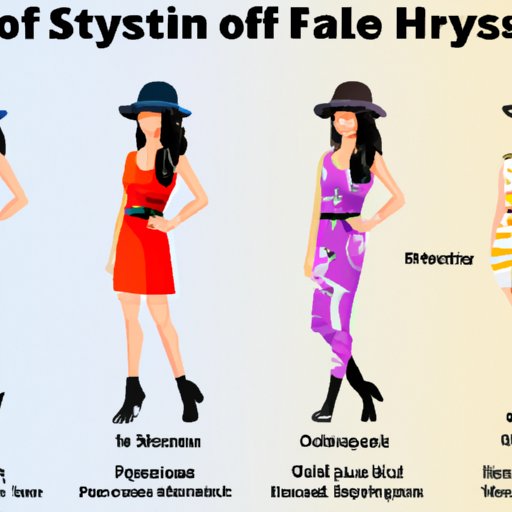Introduction
Style in fashion is an ever-evolving concept that has been shaped by different cultures and influences throughout history. From the flapper dresses of the 1920s to the oversized t-shirts of the 1990s, each decade has had its own unique style. Today, fashion continues to evolve as we explore new trends, express our personal identities through clothing, and are influenced by the culture we live in. In this article, we will explore what style in fashion is, how it has evolved over time, and how you can find your own personal style.
Defining Style in Fashion: Trends, Personal Expression, and Cultural Impact
When it comes to defining style in fashion, there are several factors that come into play. Trends play a major role in fashion, as they dictate the latest styles and looks that people are wearing. Trends often start off with celebrities or influencers who are seen wearing certain items or looks, and then they quickly become popular amongst the general public. However, trends don’t always last forever, and fashion can quickly move onto something else.
Personal expression is another important factor when it comes to style in fashion. Many people use clothing as a way to express their identity, and they may choose to dress in a certain way to show off their personality or interests. This could be anything from wearing bright colors to express one’s energy and enthusiasm, to wearing dark colors to show a more serious side. Whatever the case may be, personal expression is an important part of creating one’s own style in fashion.
Finally, culture plays an important role in fashion. Different cultures have their own unique styles and looks, which are often heavily influenced by the environment in which they live. For example, many African cultures have bright and colorful clothing, which reflects the vibrancy of the natural landscape. Similarly, many Middle Eastern cultures have modest clothing that covers the body, which reflects the values and traditions of the region. By understanding the cultural influences behind fashion, we can better understand why certain styles are popular in certain places.

Exploring the Evolution of Style in Fashion Through History
The evolution of style in fashion has changed drastically over the years. Each decade has had its own unique look and feel, which was heavily influenced by the culture and trends of the time. For example, the roaring twenties were known for the flapper dresses, which were short and often featured fringe and sequins. This era was a time of liberation for women, and this was reflected in the clothing styles of the time.
The 1950s brought about more conservative looks, with pencil skirts and poodle skirts being incredibly popular. This was partly due to the post-war economic boom, which made it easier for people to buy fashionable clothing. The 1960s saw the introduction of bold prints and bright colors, which were a reflection of the hippie movement and the counterculture of the time. The 1970s were known for the disco era, with polyester suits and platform shoes being all the rage. The 1980s saw the rise of “power dressing”, with shoulder pads and big hair becoming popular amongst working women. The 1990s saw a shift towards more relaxed and casual looks, with oversized t-shirts and jeans being the norm.
Each of these eras has had its own unique style, which has been heavily influenced by the culture and trends of the time. By examining the evolution of style in fashion, we can better understand how fashion has changed over time and how it has been shaped by different cultures.
How to Find Your Personal Style in Fashion
Finding your personal style in fashion can be a challenge, but it is possible. The first step is to identify what you like and don’t like when it comes to fashion. Look at different trends and styles and decide which ones appeal to you and which ones don’t. You can also explore different fashion websites and magazines to get a better idea of what is out there.
Once you have identified what you like, you can start to experiment with different looks. Try out different combinations of clothes and accessories to see what works for you. Don’t be afraid to take risks and try out new things – you never know what look you might end up loving!
Finally, don’t be afraid to mix and match different styles. For example, you can pair a vintage dress with a modern jacket to create a unique look. Be creative and have fun with it – you never know what look you might end up creating!

Understanding The Different Types of Style in Fashion
There are many different types of style in fashion, each with its own unique elements. These include classic, preppy, bohemian, punk, gothic, edgy, and streetwear. Each of these styles has its own distinct look and feel, which is often reflective of the culture and trends of the time.
For example, classic style is timeless and elegant, with neutral colors and clean lines. Preppy style is polished and sophisticated, with bright colors and classic silhouettes. Bohemian style is relaxed and free-spirited, with lots of layers and textured fabrics. Punk style is edgy and rebellious, with bold colors and statement pieces. Gothic style is dark and mysterious, with heavy fabrics and dark colors. Edgy style is daring and unconventional, with asymmetrical cuts and avant-garde designs. Streetwear is urban and stylish, with comfortable fabrics and contemporary silhouettes.
By understanding the different types of style in fashion, you can start to explore different looks and find the one that best reflects your personal taste. Don’t be afraid to mix and match different styles to create your own unique look!

Examining How Style in Fashion is Influenced by Social Media
In recent years, social media has had a huge impact on fashion. Platforms such as Instagram, Twitter, and YouTube have enabled influencers to share their fashion looks and styles with millions of people around the world. This has led to the rise of fast fashion, as people are constantly searching for the latest trends and looks.
Social media has also enabled people to share their own personal style with the world. People can post pictures of their outfits and share their fashion tips and advice with others. This has created a community of fashion lovers who are all connected through the power of social media.
Finally, social media has allowed brands and designers to reach a wider audience and showcase their products to potential customers. Brands can now advertise directly to their target audience, which has revolutionized the fashion industry.
Conclusion
In conclusion, style in fashion is an ever-changing concept that has been shaped by different cultures and influences throughout history. Trends, personal expression, and cultural impact all play a role in fashion, and by understanding these factors, we can better understand why certain styles are popular at any given time. We can also explore the evolution of style in fashion through history to gain a better understanding of how fashion has changed over time. Finally, by exploring our own personal tastes and experimenting with different looks, we can find our own unique style in fashion.
We hope this article has helped you to better understand what style in fashion is and how you can find your own personal style.
(Note: Is this article not meeting your expectations? Do you have knowledge or insights to share? Unlock new opportunities and expand your reach by joining our authors team. Click Registration to join us and share your expertise with our readers.)
